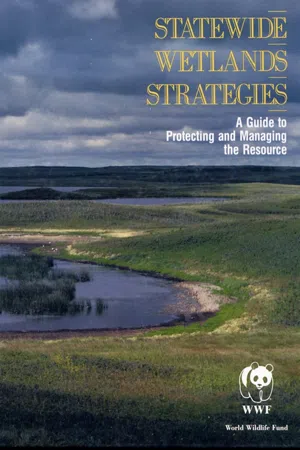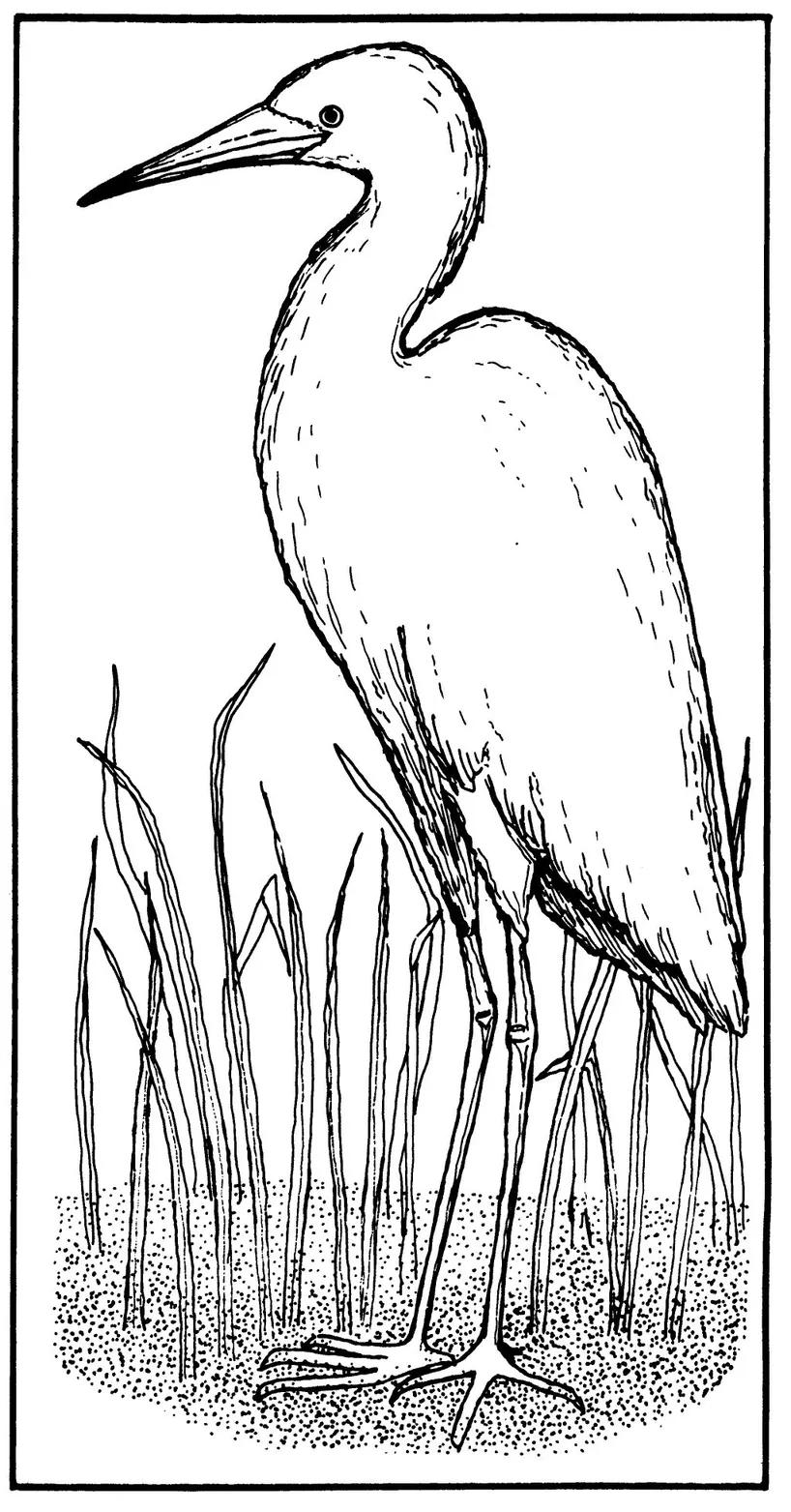
This is a test
- 285 pages
- English
- ePUB (mobile friendly)
- Available on iOS & Android
eBook - ePub
Statewide Wetlands Strategies
Book details
Book preview
Table of contents
Citations
About This Book
Statewide Wetlands Strategies offers comprehensive strategies that draw upon all levels of government and the private sector to focus and coordinate efforts to work toward the goal of no-net-loss of wetlands.
Frequently asked questions
At the moment all of our mobile-responsive ePub books are available to download via the app. Most of our PDFs are also available to download and we're working on making the final remaining ones downloadable now. Learn more here.
Both plans give you full access to the library and all of Perlego’s features. The only differences are the price and subscription period: With the annual plan you’ll save around 30% compared to 12 months on the monthly plan.
We are an online textbook subscription service, where you can get access to an entire online library for less than the price of a single book per month. With over 1 million books across 1000+ topics, we’ve got you covered! Learn more here.
Look out for the read-aloud symbol on your next book to see if you can listen to it. The read-aloud tool reads text aloud for you, highlighting the text as it is being read. You can pause it, speed it up and slow it down. Learn more here.
Yes, you can access Statewide Wetlands Strategies by World Wildlife Fund,Mark Rorner in PDF and/or ePUB format, as well as other popular books in Arquitectura & Arquitectura general. We have over one million books available in our catalogue for you to explore.
Information
Topic
ArquitecturaSubtopic
Arquitectura generalPART I
Creating a Statewide Wetlands Strategy

I.1
Setting a Direction
One of the fundamental purposes of a wetlands strategy is to integrate often disparate efforts to protect and manage wetlands, thus ensuring that all programs affecting wetlands work toward the same end. The first and most important steps in developing a wetlands strategy are to establish an overall goal and then to consider how to achieve that goal.
THE OVERALL GOAL
For states with urgent practical decisions to make, a strong overarching goal isn’t optional-it’s a necessity.
Various wetlands conservation goals have been established at federal, state, and local levels. Most of these goals, however, lack clarity and depth. Typically, they apply to only one program and speak in general terms of an intent or a need to “preserve,” “protect;” and “maintain” the resource.
To be effective, a goal needs to serve five purposes.
What a Goal Should Do
1. A goal should promote consistency.
By focusing all efforts toward the same end, a goal helps ensure that programs are consistent—that resources are not consumed by one agency or program to the detriment of another. Consistent programs can better meet the needs of the regulated community, which deals with an often frustrating array of players and programs. Consistency also provides a strong basis for coordination among programs.
A goal can promote consistency among different levels of government and the private sector while accommodating regional needs by allowing flexibility in the means used to achieve the goal.
Vermont’s Act 200 establishes 12 statewide planning goals (goal 4 is “to identify, protect, and preserve important natural resources including...wetlands”). All plans prepared by regional planning commissions and state agencies must be consistent with these goals. While the goals provide a uniform standard for encouraging appropriate development in the state, they also give local and state agencies the flexibility to use mechanisms best suited to their own situations to achieve those goals.
2. A goal should provide a benchmark for assessing progress.
The effectiveness of a strategy can’t be determined without an overarching goal. Similarly, the strategy’s components can’t be fine-tuned unless their performance is measured against a goal. (See
3. A goal should help garner support.
Establishing and publicizing a goal for a state’s wetlands strategy can be an effective way to gain support for all the activities and programs that implement the goal. A goal can help the public understand the issues. A promotional campaign focused on a goal can generate broad public awareness of the problem of wetlands loss and the strategy being developed to address the problem. For elected officials and the public, a goal can become a cause to identify with and promote.
In the early 1980s, Illinois confronted the problem of extensive and increasing soil erosion by setting a goal for addressing the problem. This goal, “Tolerable Soil Loss by the Year 2000,” was established in administrative guidelines through the state’s Soil and Water Conservation Districts Act. Since adopting the goal and raising awareness of the problem, the state’s Department of Agriculture has been successful in securing funding from the general assembly for implementing programs needed to achieve the goal.
4. A goal should provide an underlying purpose for all acdvities carried out as part of a wetlands strategy.
A goal gives strategy implementors a clear, unified rationale for their work. This can help increase motivation by providing a sense of purpose and the ability to see how specific efforts contribute to meeting the goal.
5. A goal should help transcend changes in leadership.
A change in federal, state, or local leadership can drastically change program priorities and can have a profound effect on an agency’s agenda. A strong goal helps ensure that the wetlands strategy endures through such inevitable political changes.
In 1989, Oregon adopted a plan to bolster economic growth. “Oregon Shines” established 160 goals for strengthening the state’s economy (no net loss of wetlands is included as one of the goals). Although then-governor Neil Goldschmidt did not run for reelection in 1990, both major party candidates adopted the goals as their own, and the newly elected governor, Barbara Roberts, has requested that agency heads pursue these goals. The legislature is also drafting a bill to establish these goals as state policy.a
No Net Loss and Long-Term Net Gain as the Goal
Despite important differences in the kinds of wetlands protection problems facing states and options available to address those problems, all states confront the same fundamental issue. The continuing loss and degradation of wetlands is unacceptable for both environmental and economic reasons. The goal of any wetlands strategy, then, must reflect the urgency and severity of this problem and present a realistic but ambitious target for wetlands protection and management efforts. The goal of no net loss and long-term net gain (NNL) serves such a purpose.
The NNL goal evolved during meetings of the National Wetlands Policy Forum, a group representing all major interests in wetlands policy, including government, agriculture, industry, and the environment. In November 1988, after examining the wetlands issue for a year, the Forum published its final report. It recommended that
the nation establish a national wetlands protection policy to achieve no overall net loss of the nation’s remaining wetlands base, as defined by acreage and function, and to restore and create wetlands, where feasible, to increase the quality and quantity of the nation’s wetlands resource base.
This goal has driven the wetlands policy debate since that time. President Bush has endorsed no net loss, and several states, federal agencies, and local governments have formally adopted it. (See Appendix A for excerpts from existing statutes, rules, and policies that establish goals of no net loss/net gain.)
The broad appeal of NNL is that it is a fundamentally balanced goal. It recognizes the urgent need to stabilize and eventually increase the nation’s wetlands inventory while acknowledging that some wetlands losses are inevitable because of natural events and legitimate development needs. NNL is thus a reasonable, achievable aim.
Adopting the Goal: Process Considerations
Some states have found it politically feasible to begin development of a wetlands strategy with the NNL goal as a mandate. A recently enacted Texas statute, for instance, directs the state to develop a plan for state-owned coastal wetlands that will achieve no net loss. In California, Governor Pete Wilson’s two-year conservation initiative, dubbed “Resourceful California,” calls for the state to develop a wetlands conservation plan by 1992 to achieve no net loss and long-term net gain. And Michigan, in developing its wetlands strategy, has moved directly to “net gain,” setting a goal to increase the state’s wetlands by at least 500,000 acres by the year 2000.
Is No Net Loss and Long-Term Net Gain a Practical Goal?
Lawmakers, wetlands managers, the regulated community, and others have expressed legitimate concern over the difficulties of pursuing the goal of no net loss and long-term net gain (NNL). Scientists, in particular, have stated that their ability to evaluate wetlands functions is limited; without accepted methodologies, scientists worry that they cannot accurately measure the achievement of NNL. And developers are concerned that excessive restrictions on private property and the costs of required mitigation are unreasonable and constitute too great a burden.
Although it is important to recognize these concerns, getting stumped by them is unnecessary. States can begin to address these issues in many ways. Clearly, there is a need to pursue research to improve scientific understanding of wetlands functions and how to restore and create wetlands to offset losses. To help improve compensation techniques, states can develop inventories of public and private lands to determine the best areas for wetlands restoration and creation. Pilot projects can be undertaken to evaluate various methods for restoring or creating wetlands in different locales. States can sponsor large-scale wetlands restoration/creation projects to create opportunities for wetlands “banking” or multi-purpose recreation/open-space projects.
In addition, to help ease the burden of no net loss on the regulated community, states can streamline their regulatory programs by:
- making application forms more user friendly;
- shortening permit-processing time;
- providing helpful handbooks to guide citizens and consultants through the permitting process;
- installing special telephone-access services and database management systems to help applicants track the status of their permit applications; and
- establishing coordinated state-federal mitigation and permit-processing standards.
Even with such mandated goals, states still need to find ways to involve all the interested parties in the strategy development process. This can be done by using collaborative processes to set interim goals, objectives, and methods of implementation. (Part II offers detailed information about group processes.)
Some states may find that initiating strategy development with a preordained goal is problematic. In New York, for example, even though Governor Mario Cuomo endorsed no net loss, the strategy-building process began with public workshops to establish an overall strategy goal. New York chose this alternative because of the high level of controversy that wetlands issues had generated in the state. In such cases a state should design a process to identify a...
Table of contents
- About World Wildlife Fund
- About Island Press
- Title Page
- Copyright Page
- Table of Contents
- Preface
- Introduction
- PART I - Creating a Statewide Wetlands Strategy
- PART II - Organizing a Strategy Development Process
- PART III - Mechanisms for Protecting and Managing Wetlands
- PART IV - Wetlands Data Sources and Collection Methods
- Appendixes